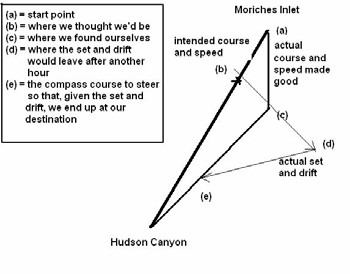By Vincent Pica, Commodore, First District, Southern Region (D1SR), United States Coast Guard Auxiliary
Imagine that you are walking along the sidewalk, trying to get to the coffee shop on the corner. But the person next to you is leaning against your shoulder, keeping pace with you and pushing you away from it. There is only one way you are going to make it to the coffee shop (short of belting the guy!). You have to lean into him to such a degree that you overcome the force of his push and the speed at which he is applying it. This is the essence of “Set and Drift” when navigating as well.
Set and Drift
The force that this rude dude above is applying to your shoulder is the “drift”; the speed at which he is walking while applying that force is the “set.” If he were the tide, or the wind for that matter, the set is the direction of the force against your hull and the drift is the speed the current is running at. The combination can be considered the force that is keeping you from (or speeding you to) the “coffee shop.”
Sailors are more concerned with these forces, as they typically travel at far slower speeds than a powered vessel and thus need greater distances to apply countervailing force to overcome it. But imagine yourself heading out to the Canyons to do some shark fishing. You leave Moriches Inlet and your pal told you to make your point of sail 200° magnetic and put the hammer down for 60 nautical miles… “Plug 39° 40’ 29” N and 071° 14’ 36” W into your GPS and fish all night…”
So, you do – and when you’ve traveled the amount of time specified, you find yourself way to the east and south of your mark. Why? Because the tidal forces of the Hudson have been just like that guy outside the coffee shop. The set (direction) of the tidal current – on your starboard quarter in this example – pushed you to port (to the east of the rhumbline), while its force (drift) added to your speed – and pushed you further south than engine speed alone would have taken you.
In reality, once you plugged a waypoint into your GPS, the GPS is calculating the “cross track error (XTE).” What is that? It is the computer doing the calculations (see below) that we all used to do by hand – except the computer can do it constantly and continuously. (We had to wait for errors big enough to matter to the human computer!) It is calculating how far off course you’ll be, taking into account your true course over the bottom, if you continue to ignore the set and drift of the current (or wind, for that matter!) In the example above, it would start to show that you’ll end up well to the east of your mark – and you’ll get there ahead of schedule! Using your helm, you start to “lean in,” i.e., in this case, you would have to turn your helm over towards starboard until the GPS says that your XTE is zero. Now, assuming that all these forces stay constant, you’ll arrive exactly where you intended (even if you get there ahead of schedule!)
But how many degrees should you have turned to starboard in this example? Rather than trial and error (“Turn a little more, dear…Wait, now a little more, dear, wait…”), couldn’t you calculate it precisely? Yes, you can!
Take a quick look at the diagram:

In upcoming issues, we’ll spell out exactly how you relate all these vectors – as well as your boat speed since that adds more countervailing power as you run at higher speeds – into a precise calculation and give you a new Course To Steer (CTS). And become a better seaman…
If you are interested in being part of the USCG Forces, email me at JoinUSCGAux@aol.com or go direct to the D1SR Human Resources department, who are in charge of new members matters, at d1south.org/StaffPages/DSO-HR.php and we will help you “get in this thing.”
Captain Andrew Tucci is the Captain of the Port and Sector Commander for US Coast Guard Sector Long Island Sound. Captain Tucci is responsible for all active-duty, reservist and auxiliary Coast Guard personnel within the Sector. As a Commodore of the US Coast Guard Auxiliary First District, Southern Region, Vin Pica works closely with Captain Tucci and his staff to promote boating safety in the waters between Connecticut, Long Island and 200 nautical miles offshore. Sector Long Island Sound Command Center can be reached 24 hours a day at 203-468-4401.



